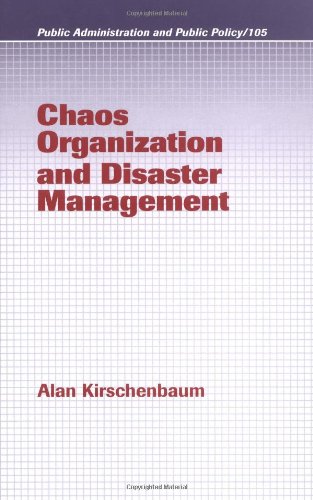

Most ebook files are in PDF format, so you can easily read them using various software such as Foxit Reader or directly on the Google Chrome browser.
Some ebook files are released by publishers in other formats such as .awz, .mobi, .epub, .fb2, etc. You may need to install specific software to read these formats on mobile/PC, such as Calibre.
Please read the tutorial at this link. https://ebooknice.com/page/post?id=faq
We offer FREE conversion to the popular formats you request; however, this may take some time. Therefore, right after payment, please email us, and we will try to provide the service as quickly as possible.
For some exceptional file formats or broken links (if any), please refrain from opening any disputes. Instead, email us first, and we will try to assist within a maximum of 6 hours.
EbookNice Team

Status:
Available5.0
20 reviews(Ebook) Chaos Organization and Disaster Management 1st Edition by Alan Kirschenbaum - Ebook PDF Instant Download/Delivery: 9780824747152 ,0824747151
Full download (Ebook) Chaos Organization and Disaster Management 1st Edition after payment

Product details:
ISBN 10: 0824747151
ISBN 13: 9780824747152
Author: Alan Kirschenbaum
(Ebook) Chaos Organization and Disaster Management 1st Edition Table of contents:
Part I The Official Organizing of Chaos
1 Creating Disasters
Taxes And Disasters
Historical Organizing Forms
From Community To Bureaucracy
Organizational Forms
Community Models
Organizational Models
Rational System Approach
Natural Systems Approach
Open System
Organizing Chaos
Information And Disaster Management
Hidden Political Agenda
New Public Management
Disaster Management Organizations
Global Disaster Management
Built-In Conflict
Community Consensus
More Agencies, More Disasters
Severity And Distribution
More People—More Disasters?
Density And Distribution
Critical Assessment
What’S Next?
2 Preparing for the Worst
A Camel Or A Horse?
Shaky Grounds
What Is Preparedness?
Surviving
Evolving Meanings
Whose Definition?
Double Meanings
Misplaced Concreteness
A Better Mousetrap
Generating Propositions
Whose Preparedness?
Answers From The Field
Sources Of A Definition
Experts’ Viewpoints
A Master List
Wherein Lies The Truth?
How To Explain Preparedness
What We Are
Whom We Meet
Our Experiences
How We Acted
How We See Risks
What Makes Us Prepare?
Keeping Stocked
Knowing What To Do
Emergency Planning
Physically Protecting Ourselves
What Can Be Learned
A Rigorous Approach
Misguided Agencies
Universal Application
Are We Really Prepared?
Notes
3 Are Disaster Agencies Effective?
Looking From Outside In
What Is Effectiveness?
Performance
Shifting Allegiances
Multiple Constituency Approach
Stakeholders
Who Counts?
Goals And Transparency
The Constituents
Why Goals?
An Effectiveness Model
Goal Measures
Stated Goals
Managers’ Goals
Gauging Effectiveness
Eyes Of The Beholder
Goals Conflict?
How Effective
What Affects Perceptions?
Sources Of Awareness
Different Goals
Are Disaster Agencies Effective?
Summary
What’s Next?
Notes
Part II The Other Side—Victims Perspective
4 The Power of Tradition
Not Seeing Eye To Eye
A Helping Hand
A Good Job
Underlying Tensions
Primordial Choices
Adaptation
Traditional Ways
Modern Tradition
Who To Rely On?
A Testing Ground
Alive And Well
Trusting Behavior
How Do You Know What To Do?
Traditional Versus Official Behavior
Choices to Mimic
Cultural Intervention
Why A Traditional Choice?
Alternative Choice Model
Sociodemographic Explanations
Cultural Constraints
Social Networking
Experience and Involvement
Assessing Risk
Trusting Behavior
A Parsimonious Model
Predicting A Choice
Social Imperatives
Trusting Your Sources
The End Game
Notes
5 The Odds of Being a Victim
An Endangered Species
Discount The Victim
Everything Is Risky
Social Rationality
Perceptions Of Risk
Scientific Risk
Cognitive-Psychological Risk
Cultural Risk
Expert Versus Victims, Risk
Organizational Blinders
Gut Feelings
What Is A Perceived Risk?
Social Context Of Risk
Socially Based Rationality
Measures Of Risk
Conventional War
Unconventional War
Industrial-Technological
Natural Disasters and Accidents
Components Of Risk Perception
Them And Me
Societal Survival
How Risks Evolve
Group Actions
Predicting Risk
Sociodemographic Variables
Social Networks
Past Experiences
Knowledge
National Disaster Risk
Property Loss
Social Networks
Strength of Ties
Strong or Weak Ties
Personal Risk From Unconventional Disaster
Sensitivity of Women
Knowledge Counts
Property
Risks In Natural Disasters
Buying Safety
Risk Of Industrial Disasters
Men Count Too
Neighborhoods
Fewer Ties, Less Risk
Why Differences?
Technological Risks
Demographic Background
Foreign-Born
Recall the Past
Education
Connected by Telephone
Risk And Harm
Does Risk Lead To Preparing?
What Have We Learned?
Notes
6 The Mother Hen Effect
Survival By Default
Gatekeepers
Bureaucratic Guards
Community Gatekeepers
Families As Gatekeepers
Gender And Disasters
Women Care More
Men Are Stronger
The Panacea Of Networks
Mother Protector Versus Macho Men
Fear Or Common Sense?
Words And Deeds
Motherhood And Fatherhood
Gender Or Children?
Children And Networking
The Puzzle
Generational Continuity
Selective Gatekeepers
Actual Preparedness
Key Players
Gendered Gatekeeper Roles
Action And Not Words
Who Prepares The Most?
The Mother Hen Effect
Cultural Framework
Ethnicity And Familism
Traditional Mother Hens
Ethnic Roots
Return To Mother Hen
Summary Of Victims’ Perspectives
Notes
Part III Alternative Organizational Forms
7 Disaster Communities as Survival Mechanisms
A False Messiah?
Mission Impossible?
Going Back In Time?
Disaster Studies In Communities
A Common Thread
Community-Level Analysis
What Is A Disaster Community?
Rippling Effect
Whose Community?
Multiple Disaster Communities
Community Social Strength
Urban Communities
Disaster Neighborhoods
Neighboring Ties
Community Preparedness
Levels Of Community Strength
Disaster Community Networks
Network Impact
Family-Based Networks
Microneighborhood Impact
Community Service Networks
Predicting Community Preparedness
Priority Emphasis
A Closer Look
Promoting Or Reducing Preparedness?
What’s Excluded?
Service-Based Networks
Networks And Ethnicity
Community Survival
The Payoff
Notes
8 Privatizing Disaster Management
What If?
A Critical Introspection
The Quick Fix
Tradition
Organizational Fix
Social Engineering
A Different Path: Privatization
Privatization Options
A Common Denominator
Privatizing Disasters
Privatized Disaster Market
People Power
Ready To Pay
Safety Net Of Services
Who Pays?
Wealth
Knowledge
Age
Family Status
Ethnic-Religious Differences
Predicting Payments
Privatization: A Recap
So Where To Now?
A Modest Proposal
Privatizing
Behaviors
Type of Disaster
Risk Perceptions
Refocus On The Victims
The Beginning
People also search for (Ebook) Chaos Organization and Disaster Management 1st Edition:
5 phases of disaster recovery
5 phases of disaster
5 ps of disaster
4 phases of a disaster
4 phases of disaster response
Tags: Alan Kirschenbaum, Chaos Organization, Disaster Management